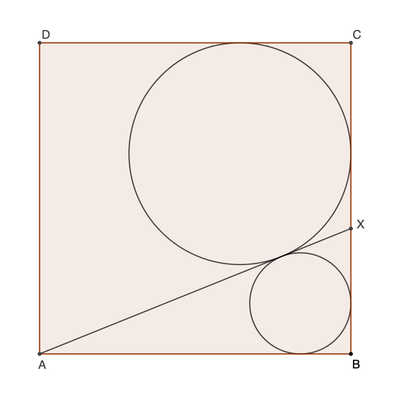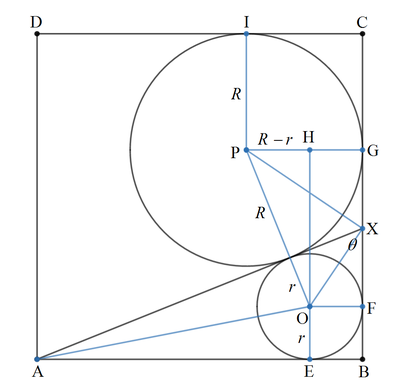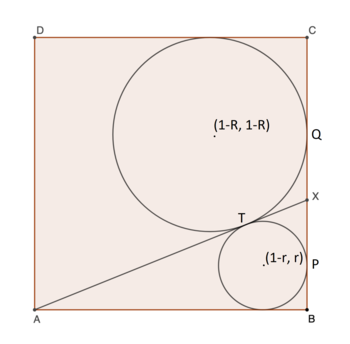It's just circles and lines
A
B
C
D
is the unit square. Point
X
is chosen on
B
C
such that the two circles are tangent to each other, the segment
A
X
, and the sides of the square as shown in the figure. What is the radius,
r
, of the smaller circle. Submit
⌊
1
0
5
r
⌋
.

The answer is 16243.
This section requires Javascript.
You are seeing this because something didn't load right. We suggest you, (a) try
refreshing the page, (b) enabling javascript if it is disabled on your browser and,
finally, (c)
loading the
non-javascript version of this page
. We're sorry about the hassle.
4 solutions
I just noticed this bit of trivium about this problem: R + r = 1
Log in to reply
True!
N T = 2 r R ⇒ 1 − R − r = 2 r R ⇒ R + r + 2 r R = 1 ⇒ ( R + r ) 2 = 1 ⇒ R + r = 1
Nice observation!
Interestingly, the fact is used in almost all of the solutions posted.
Let the radius of the larger circle be R and denote the centers of the smaller and larger circle as O 1 and O 2 respectively. Also mark points P and Q on B C such that B P is tangent to the smaller circle at P and C Q is tangent to the larger circle at Q . Note that the circles share a common point, say T , on the segment A X .
From the properties of tangents, X P = X T = X Q = x Since A B C D is a unit square, B C = B X + C X = r + x + R + x = R + r + 2 x = 1 Constructing a perpendicular to A B (parallel to B C ), though point O 1 and let it intersect O 2 Q at E . Clearly, △ O 1 E O 2 is right angled at E and has sides O 1 O 2 = R + r , O 1 E = 2 x and O 2 E = R − r . By the Pythagorean theorem, O 1 E 2 + O 2 E 2 = O 1 O 2 2 ⟹ ( 2 x ) 2 + ( R − r ) 2 = ( R + r ) 2 ⟹ 4 x 2 = 4 R r ⟹ x = R r Combining this with the previous relation, we have R + r + 2 x = R + r + 2 R r = 1 ⟹ R + r = 1 Note that the circle centered at O 1 with radius r is the incircle of △ A B X . Using the formula for the inradius of a triangle, △ = r ⋅ s , 2 ( r + x ) ( 1 ) = r ( 1 + x ) ⟹ r + x = 2 r + 2 r x ⟹ x = 1 − 2 r r Finally we have an equation in r , R r = ( 1 − r ) r = 1 − 2 r r Solving the above equation gives ⌊ 1 0 5 r ⌋ = 1 6 2 4 3

Let the centers of the small and large circles O and P , the radius of large circle be R , and points E , F , G , H , and I are feet of perpendicular. Consider B C :
B F + F G + G C E O + O H + P I r + ( R + r ) 2 − ( R − r ) 2 + R r + 2 R r + R ( R + r ) 2 ⟹ R = B C = B C = 1 = 1 = 1 = 1 − r
Let ∠ A X B = θ and consider F G :
F X + X G r cot 2 θ + R cot ( 9 0 ∘ − 2 θ ) t r + R t t 1 R r + t r R R t 2 r − 2 + r R t 2 α 2 − 2 + α 2 1 ( α − α 1 ) 2 ⟹ α ⟹ R t 2 r ⟹ t = F G = O H = 2 R r = 2 R r = 2 = 0 = 0 = 0 = 1 = 1 = 1 − r r Let t = tan 2 θ Divide both sides by R r Let α 2 = R t 2 r
Consider A B :
A E + E B r cot 2 ∠ X A B + O F r cot ( 4 5 ∘ − 2 θ ) + r r ( 1 − t 1 + t ) + r 1 − 2 r r + r 2 r r − 2 r − 2 r + 1 ⟹ r ⟹ ⌊ 1 0 5 r ⌋ = A B = 1 = 1 = 1 = 1 = 0 ≈ 0 . 1 6 2 4 3 4 5 6 5 = 1 6 2 4 3 Substitute t = 1 − r r

I solved using coordinate geometry. Let's take the origin at point A . If the radius of the big circle is R , and the radius of the small circle is r , then the center of the big circle is ( 1 − R , 1 − R ) , and the center of the small circle is ( 1 − r , r ) . Also from the fact that tangents to a circle have the same length, it follows that segments P X , T X , Q X all have the same length, and since the side length of the square is 1 , then that length is 2 1 ( 1 − R − r ) , hence point X is ( 1 , 2 1 ( 1 + r − R ) ) . The first relation we can write is that of the distance between the centers of the two circles being equal to R + r . Hence,
( R + r ) 2 = Δ x 2 + Δ y 2 = ( R − r ) 2 + ( 1 − R − r ) 2
The second equation expresses the fact the line segment joining the two centers is perpendicular to the tangent A X , hence, has a slope that is the negative of the reciprocal of its slope:
R − r 1 − R − r = 1 + r − R − 2
Simplifying the first equation yields,
r 2 − R 2 − 2 r + 4 R − 1 = 0 ( 1 )
The second equation becomes
r 2 + R 2 − 2 R r − 2 r − 2 R + 1 = 0 ( 2 )
Equations ( 1 ) , ( 2 ) have three solutions for ( r , R ) :
1 . ( 0 . 1 6 2 4 3 4 5 6 5 , 0 . 3 5 6 3 7 1 1 3 1 )
2 . ( 2 . 1 0 7 1 5 9 8 7 2 , 0 . 2 0 3 9 4 7 9 4 6 )
3 . ( 0 . 7 3 0 4 0 5 5 6 4 , 3 . 4 3 9 6 8 0 9 2 3 )
from which only the first one is valid while the other two are extraneous. Hence, the answer is ⌊ 1 0 5 ( 0 . 1 6 2 4 3 4 5 6 5 ) ⌋ = 1 6 2 4 3
I rotated the figure 90° clockwise and set BC as the X-axis with point X as the origin. Both circles touch BC (and thus the X-axis) in points (a, 0) and (-a, 0) because X must be in the middle in between these points. Define the bisectrices between AX and the X-axis as B1 and B2 respectfully and name the angle between B1 and the X-axis theta.
Define t = tan(theta)
B1 is defined as y = x.t and thus r = a.t (I switched the circles and put the smaller circle to the right for convenience) B2 must be perpendicular to B1 and is defined as y = -x/t and thus R = a/t The line AX is definde as y = x.tan(2 theta) = 2.x.t/(1 - t²)
Two conditions are to be met:
R + 2a + r = 1 or a/t + 2a + at = 1
(a + r).tan(2 theta) = 1 or (a + at).2t/(1 - t²) = 1
This yields to:
t³ + 3t² - t - 1 = 0
or
(t + 1)³ - 4(t + 1) + 2 = 0
which can be solved using the goniometric method: z = t + 1 = r cos(u)
r = 4.sqrt(3)/3
cos(3u) = -(sqrt(3)/2)³
u = 1/3.Acos(-(sqrt(3)/2)³) = 43,50178344°
z = 1.675130871
t = z - 1 = 0.675130871
r = 0.1624345647 and the answer requested is thus 16243
The other two solutions for z are easily found and inconvenient, they are:
t2 = -0.4608111272
t3 = -3.214319743
I did however not answer this question right because I had some errors and ran out of tries. But I think I did get it right in the end.
We notice that K M = K N − M N = R − r , M L = N T = 1 − R − r , A E = A S = 1 − r and A K = A C − K C = 2 − R 2 .
Triangles △ A K E and △ K M L are right triangles.
Using Pythagorean theorem on △ K M L ,
K M 2 + M L 2 = K L 2 ⇔ ( R − r ) 2 + ( 1 − R − r ) 2 = ( R + r ) 2 ⇔ R 2 + r 2 − 2 r R − 2 R − 2 r + 1 = 0 ( 1 ) Using Pythagorean theorem on △ A K E ,
K E 2 + A E 2 = A K 2 ⇔ R 2 + ( 1 − r ) 2 = ( 2 − 2 R ) 2 ⇔ R 2 − r 2 − 4 R + 2 r + 1 = 0 ( 2 )
Subtracting ( 2 ) from ( 1 ) we get
2 r 2 − 2 r R + 2 R − 4 r = 0 ⇒ R = r − 1 r 2 − 2 r ( 3 ) Substituting
( 2 ) ⇔ ( 3 ) ( r − 1 r 2 − 2 r ) 2 − r 2 − 4 ⋅ r − 1 r 2 − 2 r + 2 r + 1 = 0 ⇔ 4 r 3 − 1 2 r 2 + 8 r − 1 = 0 ⇔ r ≈ 0 . 1 6 2 4 3 4 5 6 or r ≈ 0 . 7 3 0 4 0 5 5 6 or r ≈ 2 . 1 0 7 1 5 9 8 7 Obviously, r is less than half the diagonal of the square, i.e. r < 2 2 ≈ 0 . 7 0 7 , hence r ≈ 0 . 1 6 2 4 3 4 5 6 . For the answer, ⌊ 1 0 5 r ⌋ = 1 6 2 4 3 .